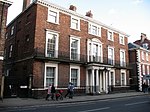Bootham Park Hospital
1770s establishments in EnglandBoothamBuildings and structures completed in 1777Defunct hospitals in EnglandFormer psychiatric hospitals in England ... and 4 more
Grade I listed buildings in YorkHospital buildings completed in the 18th centuryHospitals in YorkUse British English from April 2018

Bootham Park Hospital was a psychiatric hospital, located in the Bootham district of York, England. It was managed by the Tees, Esk and Wear Valleys NHS Foundation Trust. The main building is a Grade I listed building.
Excerpt from the Wikipedia article Bootham Park Hospital (License: CC BY-SA 3.0, Authors, Images).Bootham Park Hospital
Grosvenor Terrace, York Clifton
Geographical coordinates (GPS) Address Nearby Places Show on map
Geographical coordinates (GPS)
| Latitude | Longitude |
|---|---|
| N 53.967 ° | E -1.087 ° |
Address
Grosvenor Terrace
YO30 7AG York, Clifton
England, United Kingdom
Open on Google Maps











